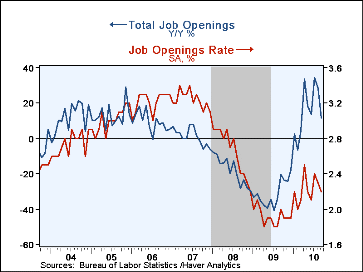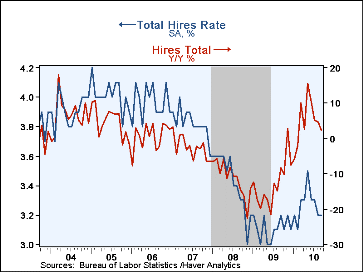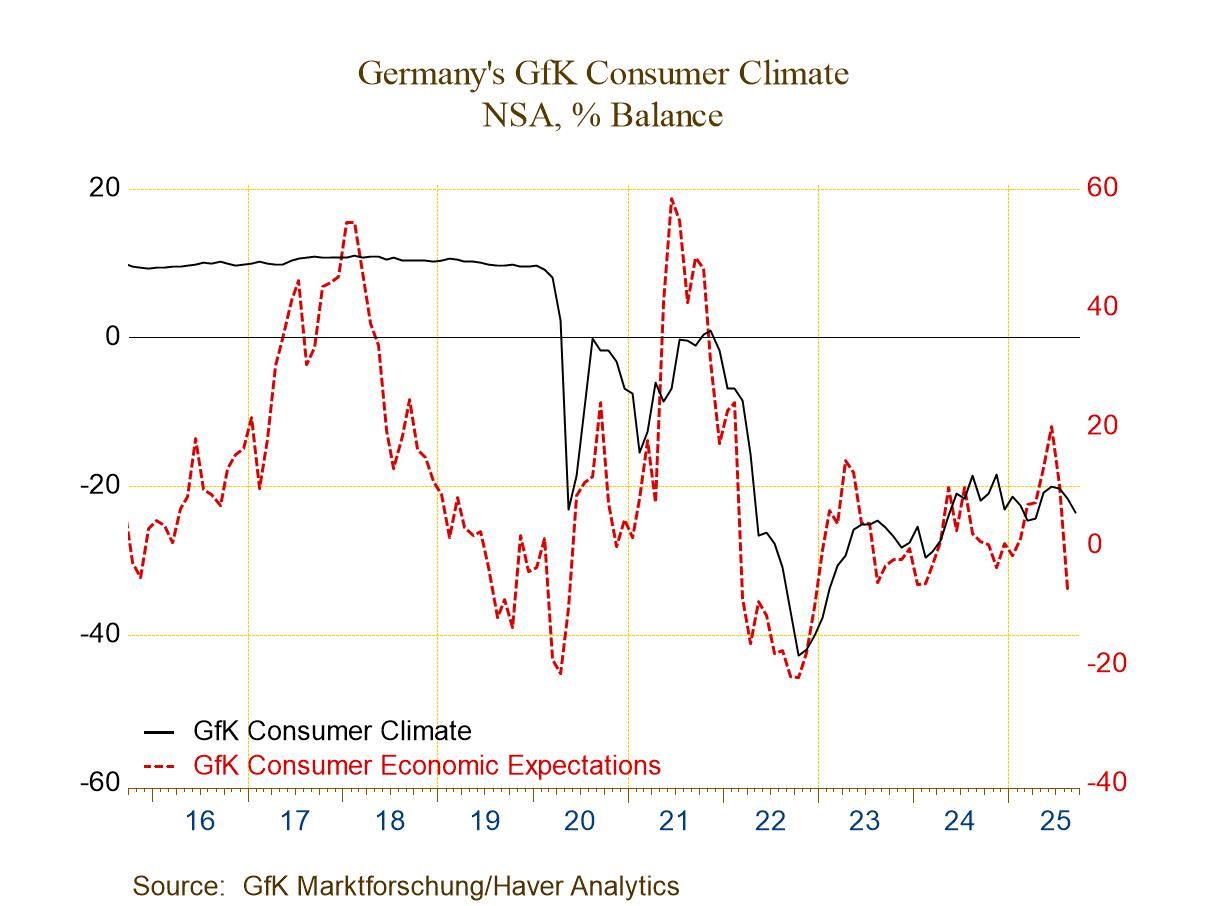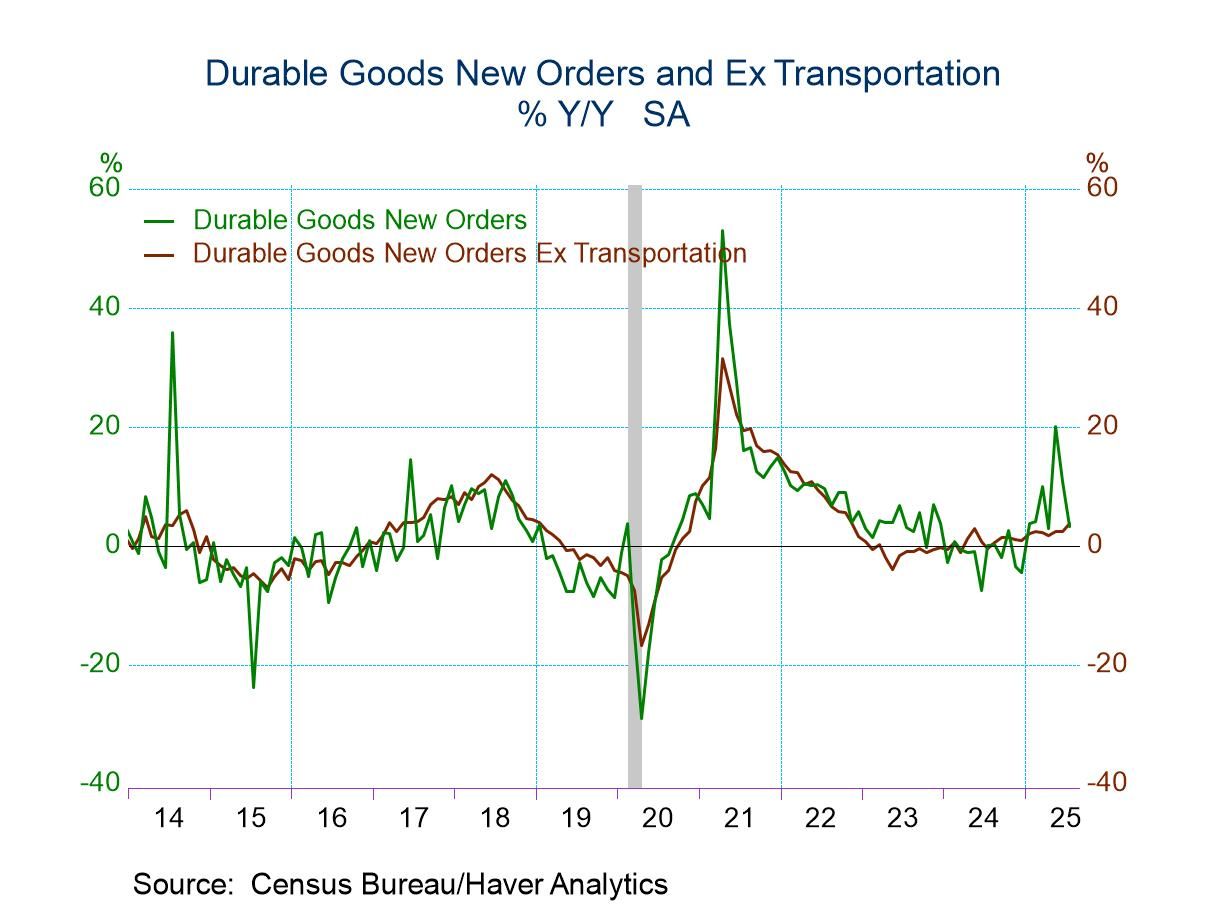 Global| Nov 09 2010
Global| Nov 09 2010JOLTS: U.S. Job Openings Rate Backs Off Again
by:Tom Moeller
|in:Economy in Brief
Summary
Reversing the earlier indication of labor market improvement, the Bureau of Labor Statistics indicated in its Job Openings & Labor Turnover Survey (JOLTS) that the September job openings rate fell to 2.2% from a downwardly revised [...]
 Reversing the earlier indication of labor market improvement, the Bureau of
Labor Statistics indicated in its Job Openings & Labor Turnover Survey
(JOLTS) that the September job openings rate fell to 2.2% from a
downwardly revised 2.3%. Both figures remained slightly lower than the April
high of 2.5% but were much improved versus the recession low of 1.8%. The job
openings rate is the number of job openings on the last business day of the
month as a percent of total employment plus job openings. Job availability
fell 5.3% in September and was down in four of the last five months. Job
availability has risen 15.7% since December after last year's 17.8% decline
which followed a 29.7% drop during 2008.
Reversing the earlier indication of labor market improvement, the Bureau of
Labor Statistics indicated in its Job Openings & Labor Turnover Survey
(JOLTS) that the September job openings rate fell to 2.2% from a
downwardly revised 2.3%. Both figures remained slightly lower than the April
high of 2.5% but were much improved versus the recession low of 1.8%. The job
openings rate is the number of job openings on the last business day of the
month as a percent of total employment plus job openings. Job availability
fell 5.3% in September and was down in four of the last five months. Job
availability has risen 15.7% since December after last year's 17.8% decline
which followed a 29.7% drop during 2008.
The private-sector job openings rate slipped to 2.3% from its recent high of 2.5%. The level of job openings rose 11.2% y/y and reflected a 39.6% gain in factory openings as well as a 20.4% increase in professional & business services. However, in education & health services openings fell 13.4% y/y after declines of roughly 16% during the last two years. Job openings in government rose 14.7% y/y but the rate remained a low 1.5% and the hires rate was a lower 1.1%. The hires rate is the number of hires during the month divided by employment.
The job separations rate held at a low 3.2% but was up from the series' low of 3.1% in April. The actual number of separations fell for the third consecutive month (-2.0% y/y). However, job separations in the private sector fell a sharp 4.6% y/y as separations in the government sector jumped by one-third y/y. Separations include quits, layoffs, discharges, and other separations as well as retirements. The layoff & discharge rate alone held at a low 1.4%, as the actual number of layoffs fell 20.0% y/y following a 12.6% increase during 2009. The private sector layoff rate held at its low of 1.5% and it fell 0.9% in the government sector.
The JOLTS survey dates only to December 2000 and the figures are available in Haver's USECON database.
Rejecting the Requiem is the title of yesterday's speech Fed Governor Kevin Warsh and it can be found here.
| JOLTS (Job Openings & Labor Turnover Survey) | Sept. | Aug. | July | Sept.'09 | 2009 | 2008 | 2007 |
|---|---|---|---|---|---|---|---|
| Job Openings, Total | |||||||
| Rate (%) | 2.2 | 2.3 | 2.4 | 2.0 | 1.9 | 2.2 | 3.1 |
| Total (000s) | 2,929 | 3,092 | 3,141 | 2,624 | 2,531 | 3,078 | 4,378 |
| Hires, Total | |||||||
| Rate (%) | 3.2 | 3.2 | 3.3 | 3.2 | 37.3 | 41.1 | 45.9 |
| Total (000s) | 4,190 | 4,156 | 4,275 | 3,997 | 48,649 | 56,082 | 63,234 |
| Layoffs & Discharges, Total | |||||||
| Rate (%) | 1.4 | 1.4 | 1.6 | 1.6 | 20.7 | 17.7 | 16.5 |
| Total (000s) | 1,792 | 1,861 | 2,112 | 2,049 | 27,683 | 24,589 | 22,606 |
Tom Moeller
AuthorMore in Author Profile »Prior to joining Haver Analytics in 2000, Mr. Moeller worked as the Economist at Chancellor Capital Management from 1985 to 1999. There, he developed comprehensive economic forecasts and interpreted economic data for equity and fixed income portfolio managers. Also at Chancellor, Mr. Moeller worked as an equity analyst and was responsible for researching and rating companies in the economically sensitive automobile and housing industries for investment in Chancellor’s equity portfolio. Prior to joining Chancellor, Mr. Moeller was an Economist at Citibank from 1979 to 1984. He also analyzed pricing behavior in the metals industry for the Council on Wage and Price Stability in Washington, D.C. In 1999, Mr. Moeller received the award for most accurate forecast from the Forecasters' Club of New York. From 1990 to 1992 he was President of the New York Association for Business Economists. Mr. Moeller earned an M.B.A. in Finance from Fordham University, where he graduated in 1987. He holds a Bachelor of Arts in Economics from George Washington University.








